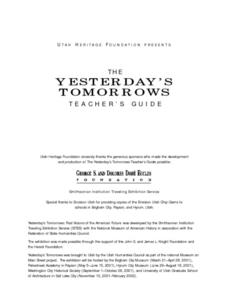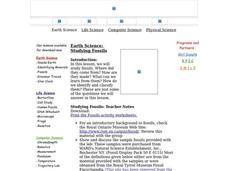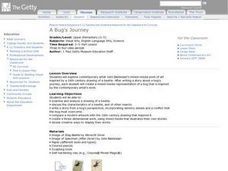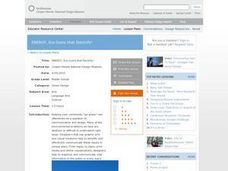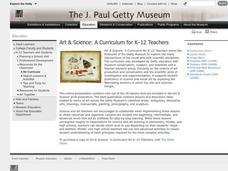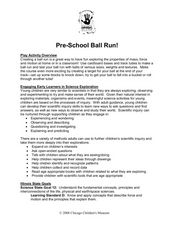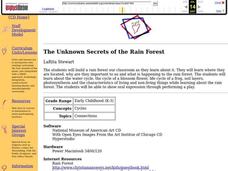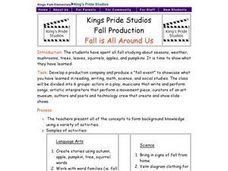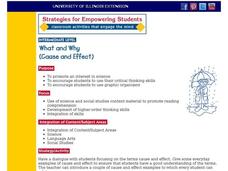Curated OER
The Yesterday's Tomorrow Teacher's Guide
Young scholars explore the future and the importance of the past. In this futuristic lesson, students create a future city and identify traditions of their heritage that they feel should be passed on to future generations. They also...
Curated OER
Studying Fossils
Students study fossils. They examine samples of specific fossils--including a shark tooth, a brachiopod, and horn coral, among others. They visit corresponding websites and complete a worksheet regarding each of the fossils.
Curated OER
Insect Anatomy
Students explore the anatomy of an insect. In this activity the characteristics of insects, students explore parts of an insect. Students gain knowledge through pictures and charts showing insects and their body parts. Students will...
Curated OER
The ABC's of Artifacts
Students create their own ABC book about artifacts. In this artifact lesson, students read ABC History Mystery and review the artifacts pictured in the book. They create their own ABC book with each student working on a letter.
Curated OER
A Bug's Journey
Students examine the artwork of John Baldessari that was inspired by a 16th century drawing of a beetle. They analyze a drawing of a beetle, discuss the insect's characteristics, and write a story from the perspective of a bug. Also,...
Curated OER
Students Solutions - Saving Our Surroundings
Pupils explore the environmental impact of humans on the plants and animals in their state. In this environmental impact lesson, students use digital cameras to photograph plants and animals in their state. Pupils investigate the animal...
Curated OER
Mobility: A Green City, Past, Present, and Future
Students explore transportation systems through history. In this transportation instructional activity, students determine how modes of transportation affect quality of life and design transportation plans for cities.
Curated OER
Energy: Eco-Icons that Electrify
Middle schoolers examine environmental issues. For this energy lesson, students explore the topic of energy conservation and then create marketing (to be implemented in their school) meant to communicate the benefits of energy conservation.
Curated OER
Fashion Forward, Fashion Functional
Middle schoolers consider the implications of waste. In this waste streams lesson, students learn what waste streams are and identify their impact on the environment. Middle schoolers also recycle waste materials to create functional...
Curated OER
A Journey Through Our Solar System
High schoolers investigate the concept of the solar system in our universe by constructing a model that is made to a measurable scale. Once the model is constructed it should be placed in a wide open space for observation and...
Curated OER
Bats
Students hypothesize and model how the bones in a bat wing are made up. In this exploratory activity students test their hypothesis, develop questions about bat parts and watch a video on bats.
Curated OER
Products Made from Petroleum
High schoolers research products made from petroleum. In this transportation activity students try to find products other than fuel, made from petroleum. They look for the most unusual or surprising products and describe the history and...
Curated OER
Bats
Students model how the bones in a bat wing are organized. They develop questions about bat body parts based on photographs. They hypothesize how bats locate their food.
Curated OER
Robert Boyle and Experimental Methods
Students discuss the difference between the Baconian inductive method and the Aristotelian deductive approaches. They complete a given set of questions then discuss them with the class.
Curated OER
Medieval Natural Resources
Students discuss and view examples of the illuminated manuscripts that were created during medieval times and into the Renaissance. In small groups, they research the resources that were used to create the manuscripts and classify them...
Curated OER
Pre-School Ball Run
Students demonstrate force and motion by rolling a ball through a tube. In this motion lesson students explore what happens to the ball when it is rolled with other balls of various sizes, weights, and textures.
Curated OER
A Fiedl Study of an Integral Species
Young scholars compile baseline population information on a local species. They design and conduct a scientific investigation of a local species. Students interpret, analyze and communicate results based on sound scientific and...
Curated OER
Fiber of Life
Students examine the importance of plants to individuals and society through a multi-discipline set of activities. They observe and draw different leaf structures and then create a book about trees and photosynthesis. They explore ways...
Curated OER
The Unknown Secrets of the Rain Forest
Students listen to the story "The Great Kapok" then discuss characteristics of the rain forest. They make several different types of rain forest animals from paper plates (ex. sloth, tigers, monkeys etc) and design costumes for a...
Curated OER
Fall is All Around Us
Young scholars develop and create a production company and produce a fall event that demonstrates what they have learned in various subject areas. STudents create stories, complete a venn diagram comparing fall and summer, graph and...
Curated OER
The First Farmers
Students show how constant irrigation, with repeated evaporation of water that left salts in the soil, eventually ruined much farming land in southern Mesopotamia. They discuss the idea that with the development of irrigation people...
Curated OER
What and Why (Cause and Effect)
Students examine cause and effect. In this cause and effect lesson, students discuss examples of cause and effect that their instructor shares with them. Students identify examples of cause and effect in their own lives and then complete...
Curated OER
Design Team Challenge
Students work in groups to build a robot. In this robotics lesson, students create an electronic robot and program it to follow directions. They create an obstacle course for the robot to follow and test its performance.
Curated OER
Marshland Ecosystem
Students classify animals based on their physical characteristics and eating habits. In this animal identification lesson plan, students investigate the life forms shown on a Parisian ceramic basin, and discover ecosystem the artist was...


